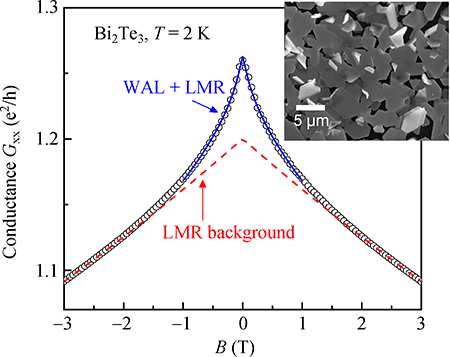
Whereas, it is known that the bulk states of the existing three-dimensional (3D) TIs are not perfectly insulating even at low temperatures, and as a direct consequence, the bulk states can also influence the transport behaviors of TIs. Plentiful interesting behaviors of TIs, particularly in the topologically protected surface states, have been explored through electrical transport experiments 7 8 9 10 11 12 13 14 15 16 17 18 19 20 21 22. As a result of the strong spin-orbit coupling (SOC), the spin-momentum locked surface states always show weak antilocalization (WAL) effect 4 5 6 due to the acquired π Berry phase when completing a time-reversed self-crossing path. Topological insulators (TIs), a new type of quantum materials characterized by the existence of a gap in the energy spectrum and the symmetry-protected surface states within the bulk gap, have attracted significant interest in recent years 1 2 3. It presents an important step toward a better understanding of the existing three-dimensional topological insulators and the potential applications of nano-scale topological insulator devices. Our work directly shows the crossover of quantum interference effect in the bulk states from weak antilocalization to weak localization. The measured magneto-resistance exhibits interesting anisotropy with respect to the orientation of parallel magnetic field B // and the current I, signifying intrinsic spin-orbit coupling in the Bi 2Se 3 films. In particular, the crossover from weak antilocalization to weak localization in the bulk states is observed in the parallel magnetic field measurements up to 50 Tesla. The angle-resolved photoemission spectroscopy data show that the Fermi level of the system lies in the bulk conduction band above the Dirac point, suggesting important contribution of bulk states to the transport results. Systematic comparison of the transport properties of single-valley Weylįermions, 2D massless Dirac fermions, and 3D conventional electrons.We report transport studies on the 5 nm thick Bi 2Se 3 topological insulator films which are grown via molecular beam epitaxy technique. Temperatures and leads to a tendency to localization. Interaction and disorder scattering always dominates the conductivity at low In addition, we find that the interplay of electron-electron In the presence of strong intervalley scattering andĬorrelations, we expect a crossover from the weak antilocalization to weak Magnetoconductivity near zero field, thus gives one of the transport signaturesįor Weyl semimetals. The weak antilocalization always dominates the Including the contributions from the weak antilocalization, Berry curvatureĬorrection, and Lorentz force, we compare the calculated magnetoconductivity Magnetoconductivity is negative and proportional to the square root of magneticįield at low temperatures, as a result of the weak antilocalization. For a single valley of Weyl fermions, we find that the

#Weak antilocalization phase coherence pdf
Download a PDF of the paper titled Weak antilocalization and localization in disordered and interacting Weyl semimetals, by Hai-Zhou Lu and Shun-Qing Shen Download PDF Abstract: Using the Feynman diagram techniques, we derive the finite-temperatureĬonductivity and magnetoconductivity formulas from the quantum interference andĮlectron-electron interaction, for a three-dimensional disordered Weyl


 0 kommentar(er)
0 kommentar(er)
